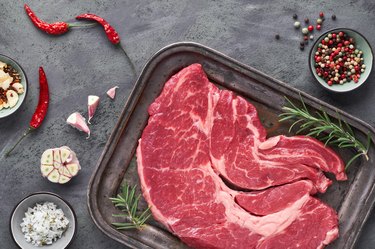
A 1,200 pound steer idly chewing grass in its pasture may jump-start the salivary glands in a cattleman or butcher, but to the casual observer, that steer is simply a cow, one that will ultimately end up in the meat case at your local grocery store or butcher shop. And it's the wide selection of cuts of beef in that meat case that is confusing to the consumer.
Knowing which cuts come from which part of the steer — and how to choose and prepare the right cut for your menu — puts you ahead in the culinary game. Plus, it may even alter your mindset when you're gazing at the grazing animals.
Video of the Day
Video of the Day
Cutting Up the Cow
Looking at a cow from the side, with its head to the left, and then from the neck to the rear, you can see that the carcass can be sectioned off into eight parts. These eight parts of a cow form the primal cuts, from which all the individual pieces of meat are butchered into subprimal cuts. The primal cuts have no connection to prime beef, which relates to the location of origin and the tenderness of a steak; instead, they are the master sections that yield all the other cuts.
From the front and moving to the rear, the eight primal cuts are:
Front:
- Chuck (top)
- Brisket (middle)
- Shank (bottom)
One Section Back:
- Rib (top)
- Plate (bottom)
One More Section Back:
- Loin (top)
- Flank (bottom)
From the Rear:
- Round (top)
- Shank (bottom)
Front Subprimal and Retail Cuts
Once the primal cuts have been sectioned, a butcher can then start cutting them into subprimal cuts. Each primal cut yields a multitude of subprime chunks, each of which still needs further cutting and trimming before it's ready to be packaged for the meat case.
Chuck primal is one of the tougher sections of the cow because it comes from the shoulder, which means the steer uses that part of its body every time it moves. The chuck primal can be cut into at least 16 subprimal cuts, with the chuck roast, short ribs and ground chuck considered the most popular retail cuts. Overall, the chuck primal cut yields meaty, rich, hearty beef that becomes more tender the longer it cooks.
The brisket primal comes from the breast of the steer, which is also used when the cow or steer moves. Subprime cuts from the whole brisket include the first-cut flat brisket and the juicy point. Both are lean and benefit from long, slow cooking.
The shank, or leg, is usually cut across the body part into discs. You'll recognize them in the meat case by their round shape, and cooks know to slowly braise the center cross-cut and serve it as osso buco. Cajun beef gumbo is enhanced by the foreshank.
Recognizing Rib and Plate Subprimals
The meat situated under ribs six through12 of the steer are just "going along for the ride." This portion of the cow provides support for the ribs, but it doesn't move around a lot, making it a more tender source of subprime cuts. The most popular is the rib roast, from which the rib-eye steak, also known as the Delmonico, is cut.
Under the rib section is the plate, known for its fatty content. Subprimals include hanger steak, inside and outside skirt steaks, and plate short ribs. Marinating the various subprimals of the plate yields a tender piece of beef, and grilling enhances the blending of the marinade with the searing flame.
Tender Is the Loin Primal
The loin of the beef, located directly behind the ribs and benefiting from a life of leisure, is the most tender and most expensive of the primals. Divided into five subprimals, consisting of the short loin, sirloin, tenderloin, top and bottom sirloins, each part yields the most sought-after cut of beef.
New York strip steaks and T-bones are cut from the short loin, while the sirloin steak and roast originate from the top of the steer, sometimes referred to as the backstrap. Cutting horizontally across the steer between the sirloin and top sirloin is the tenderloin, a cut that defines its name. Filet mignon and tenderloin roasts, with their melt-in-the-mouth tenderness and soft meat, are the prize cuts not only from the subprime, but from the entire steer.
The bottom sirloin is home to the tri-tip roast, a cut that benefits from searing and cooking at a long, low temperature.
Lonely Is the Flank Primal
The flank steak comes from the flank primal. A very lean piece of meat, the cut benefits from a marinade and short grilling time. London broil, not a cut, but a name, is also a subprimal from the flank.
The Locomotive — the Rump
Situated high on the steer's body and at its rear, the round primal propels the cow. It's the movement machine, and as a result, the meat from the rump area is tough and lean. Top round and rump roasts are two subprimal cuts that are butchered into roasts and steaks.